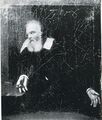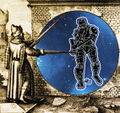Template:Selected anniversaries/August 25: Difference between revisions
No edit summary |
No edit summary |
||
| Line 66: | Line 66: | ||
||1956: George Washington Pierce dies ... inventor who was a pioneer in radiotelephony and a noted teacher of communication engineering. He did work that led to the practical application of a variety of experimental discoveries in piezoelectricity and magnetostriction. He developed the Pierce oscillator, which utilizes quartz crystal to keep radio transmissions precisely on the assigned frequency and to provide similar accuracy for frequency meters. His other accomplishments include the mathematical calculation of the radiation properties of radio antennae; invention of the mercury-vapor discharge tube, which was the forerunner of the thyratron; invention of a method of recording sound on film; and sound generation by bats and insects. Pic: https://web2.ph.utexas.edu/utphysicshistory/GeorgeWPierce.html | ||1956: George Washington Pierce dies ... inventor who was a pioneer in radiotelephony and a noted teacher of communication engineering. He did work that led to the practical application of a variety of experimental discoveries in piezoelectricity and magnetostriction. He developed the Pierce oscillator, which utilizes quartz crystal to keep radio transmissions precisely on the assigned frequency and to provide similar accuracy for frequency meters. His other accomplishments include the mathematical calculation of the radiation properties of radio antennae; invention of the mercury-vapor discharge tube, which was the forerunner of the thyratron; invention of a method of recording sound on film; and sound generation by bats and insects. Pic: https://web2.ph.utexas.edu/utphysicshistory/GeorgeWPierce.html | ||
||1961: Morris William Travers dies ... chemist who, while working with Sir William Ramsay in London, discovered the element krypton (30 May 1898). The name derives from the Greek word for “hidden.” It was a fraction separated from liquified air, which when placed in a Plücker tube connected to an induction coil yielded a spectrum with a bright yellow line with a greener tint than the known helium line and a brilliant green line that corresponded to nothing seen before. Pic: https://www. | ||1961: Morris William Travers dies ... chemist who, while working with Sir William Ramsay in London, discovered the element krypton (30 May 1898). The name derives from the Greek word for “hidden.” It was a fraction separated from liquified air, which when placed in a Plücker tube connected to an induction coil yielded a spectrum with a bright yellow line with a greener tint than the known helium line and a brilliant green line that corresponded to nothing seen before. Pic search: https://www.google.com/search?q=Morris+Travers | ||
||1965: Hedley Ralph Marston dies ... biochemist ... In the 1950s, Marston's research into fallout from the British nuclear tests at Maralinga brought Marston into bitter conflict with the government appointed Atomic Weapons Tests Safety Committee. He was vindicated posthumously by the McClelland Royal Commission, which found that significant radiation hazards existed at many of the Maralinga test sites long after the tests. Pic. | ||1965: Hedley Ralph Marston dies ... biochemist ... In the 1950s, Marston's research into fallout from the British nuclear tests at Maralinga brought Marston into bitter conflict with the government appointed Atomic Weapons Tests Safety Committee. He was vindicated posthumously by the McClelland Royal Commission, which found that significant radiation hazards existed at many of the Maralinga test sites long after the tests. Pic. | ||
| Line 74: | Line 74: | ||
||1973, the first scan was made using CAT (Computer Assisted Tomography). | ||1973, the first scan was made using CAT (Computer Assisted Tomography). | ||
||1975: John Ray Dunning dies ... physicist who played key roles in the Manhattan Project that developed the first atomic bombs. He specialized in neutron physics, and did pioneering work in gaseous diffusion for isotope separation. | ||1975: John Ray Dunning dies ... physicist who played key roles in the Manhattan Project that developed the first atomic bombs. He specialized in neutron physics, and did pioneering work in gaseous diffusion for isotope separation. Pic. | ||
||1981: Leonidas Alaoglu dies ... Canadian-American mathematician and theorist ... known for his result, called Alaoglu's theorem on the weak-star compactness of the closed unit ball in the dual of a normed space, also known as the Banach–Alaoglu theorem. Pic: http://www.math.caltech.edu/events/alaoglu14.html Death date: https://www.findagrave.com/memorial/131213394/leonidas-alaoglu | ||1981: Leonidas Alaoglu dies ... Canadian-American mathematician and theorist ... known for his result, called Alaoglu's theorem on the weak-star compactness of the closed unit ball in the dual of a normed space, also known as the Banach–Alaoglu theorem. Pic: http://www.math.caltech.edu/events/alaoglu14.html Death date: https://www.findagrave.com/memorial/131213394/leonidas-alaoglu | ||
Revision as of 08:43, 24 January 2019
1609: Galileo Galilei demonstrates his first telescope to Venetian lawmakers.
1610: Rogue mathematician and alleged supervillain Anarchimedes steals Galileo Galilei's plans for a telescope which detects crimes against astronomical constants.
1698: Physicist, mathematician, and inventor Denis Papin demonstrates new version of his steam digester which uses Gnomon algorithm principles to generate gray light and cryptographic numina.
1699: Mathematician and mechanician Charles Étienne Louis Camus born. He will be the author of Cours de mathématiques (Paris, 1766), along with a number of essays on mathematical and mechanical subjects.
1818: Mechanical soldier Clock Head receives several patents for an improvements to steam engines.
1819: inventor, engineer, and chemist James Watt dies. He made major improvements to the steam engine.
1933: Clock Head 2 publishes new class of Gnomon algorithm functions which detect and prevent crimes against mathematical constants.
1934: Inventor Philo Farnsworth demonstrates his electronic television system to the public at the Franklin Institute in Philadelphia.
1948: The House Un-American Activities Committee holds first-ever televised congressional hearing: "Confrontation Day" between Whittaker Chambers and Alger Hiss.
2012: Voyager 1 crossed the heliopause to become the first spacecraft to enter interstellar space and study the interstellar medium.
2016: Polymath George Spencer-Brown dies. He wrote Laws of Form, calling it the "primary algebra" and the "calculus of indications".
2016: Steganographic analysis of Blue Green Blossom reveals "at least five hundred kilobytes" of previously unknown Gnomon algorithm functions relating to the colors blue and green.











